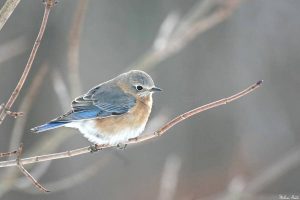Initially the bluebird trails at Badger Army Ammunition Plant were part of a study assessing risks to wildlife from exposure to residual soil contamination left by the Army. The bluebird trails at Badger are now part of a national effort to monitor and increase the production of the Eastern Bluebird and other native cavity-nesting birds.
Volunteers Bill and Donna Stehling and John Schubring monitor bluebird nests at Badger from about April through August and perhaps a bit of September, depending on the weather and the birds. They report their data to the Bluebird Restoration Association of Wisconsin in September.
Each week for each house, these dedicated volunteers count nests, type of nest, number of eggs, number of hatchlings (chicks), and number that fledge. They note problems with predators and deal with wasp nests, blow flies, and ants. They record time, temperature, wind, and sky conditions.
For many generations, bluebirds lived in orchards and around pastures, nesting in tree hollows and holes in fence posts. Urban sprawl and rural subdivisions have diminished their needed habitat. Changes in agriculture practices and competition from the House (English) Sparrow and European Starling have also affected bluebird populations.
All birds are sensitive to loud, sudden or continuous noise. Birds hear the low and high sounds that people do not hear as well. For this reason, loud disruptive activities like an ATV track or gun range are expected to negatively affect bluebirds and other bird species at Badger.
In cooperation with bluebird volunteer Donna Stehling, CSWAB has published a new flyer about opportunities to support bluebird conservation on the Badger lands and in the Sauk Prairie area.
To voice your opposition to an ATV trail and gun range at Badger, please sign the online petition to the Wisconsin DNR. If you have already signed, please share this message with a friend.


